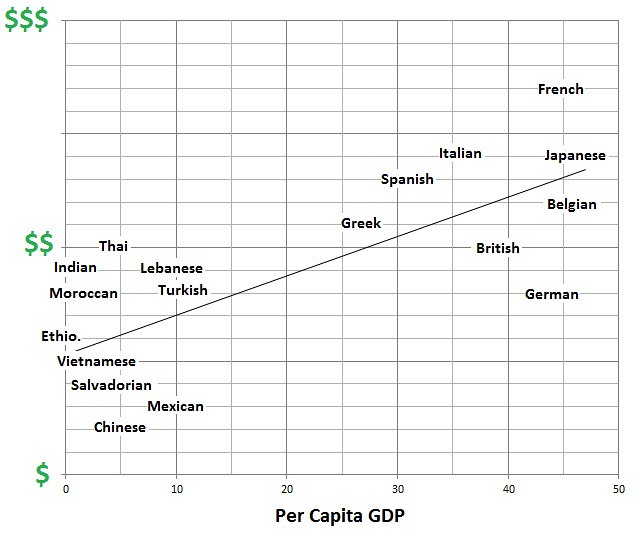Nick Danforth, Georgetown University
After presenting a number of other people's beautifully drawn maps, I am excited to put up a crudely drawn one of my own. This map shows where foods that, in America, are generally thought of as generically Middle Eastern or Mediterranean are commonly consumed. A more detailed mapping of each of these foods can be found at ottomanfoodmap.com. A nicer version, done by a real cartographer appears in the recently published Food: an Atlas. In any case...
"Lebanese and later Greek immigrants brought a number of unique dishes to America, where they gradually cohered into a unified cusine. As our maps show, these foods do indeed span a wide region, crossing religious, national and linguistic boundaries. Yet they also define unique culinary, cultural and geographic regions. The practice of drinking strong coffee in small cups with grounds, for example, reaches from the Balkans all the way to North Africa. Hummus, though, is relatively rare in Greece and Turkey. Like fallafel, its northern limit is strangely co-terminus with that of the Arabic language. Distilled liquor flavored with anise is drunk under a variety of names - Ouzo, Raki, Arak - across the region. In the Balkans, however, Raki refers to a different, more popular drink that more closely resembles Grappa or paint thinner. Yogurt is not even featured, being almost inescapable in the region (as if to illustrate this whole phenomenon, it has come to our attention that the founder of America's most popular Greek yogurt brand, Chobani, is of Turkish origin). The availability of octopus, not surprisingly, is limited by the unique geology of the Aegean sea. Ottoman Food Map allows readers to explore for themselves the geography of these foods, with a minimal degree of commentary and illustration. We have not dared to offer any speculation on national origins, nor have we tried to map the spread of cultural tendencies, like the mustache, that are universal."
 On a related note, I will take this opportunity to share the result of a similarly unscientific study into the relative price of different cuisines (according to the top ten yelp reviews per cuisine in the DC area) versus the GDP of the countries those cuisines are associated with. The results are hardly surprising. Not only is there a general correlation, but at both ends of the spectrum some countries punch above their weight (France, Thailand) and others well below (Germany). Still, there is something troubling about seeing that, yes, the average meal at a British restaurant costs more than the average infinitely better meal at an Ethiopian one.
On a related note, I will take this opportunity to share the result of a similarly unscientific study into the relative price of different cuisines (according to the top ten yelp reviews per cuisine in the DC area) versus the GDP of the countries those cuisines are associated with. The results are hardly surprising. Not only is there a general correlation, but at both ends of the spectrum some countries punch above their weight (France, Thailand) and others well below (Germany). Still, there is something troubling about seeing that, yes, the average meal at a British restaurant costs more than the average infinitely better meal at an Ethiopian one.Interestingly, Turkey seems to making strides in the US food market in keeping with its rapidly growing economy, as well as its rising cultural capital. Turkish chefs have tried to create a gourmet kebab market to mirror the success of the gourmet hamburger market, present mezes as a form of Turkish tapas and pair village cheeses like Tulum with honey and fruit in pricey cheese plates.





